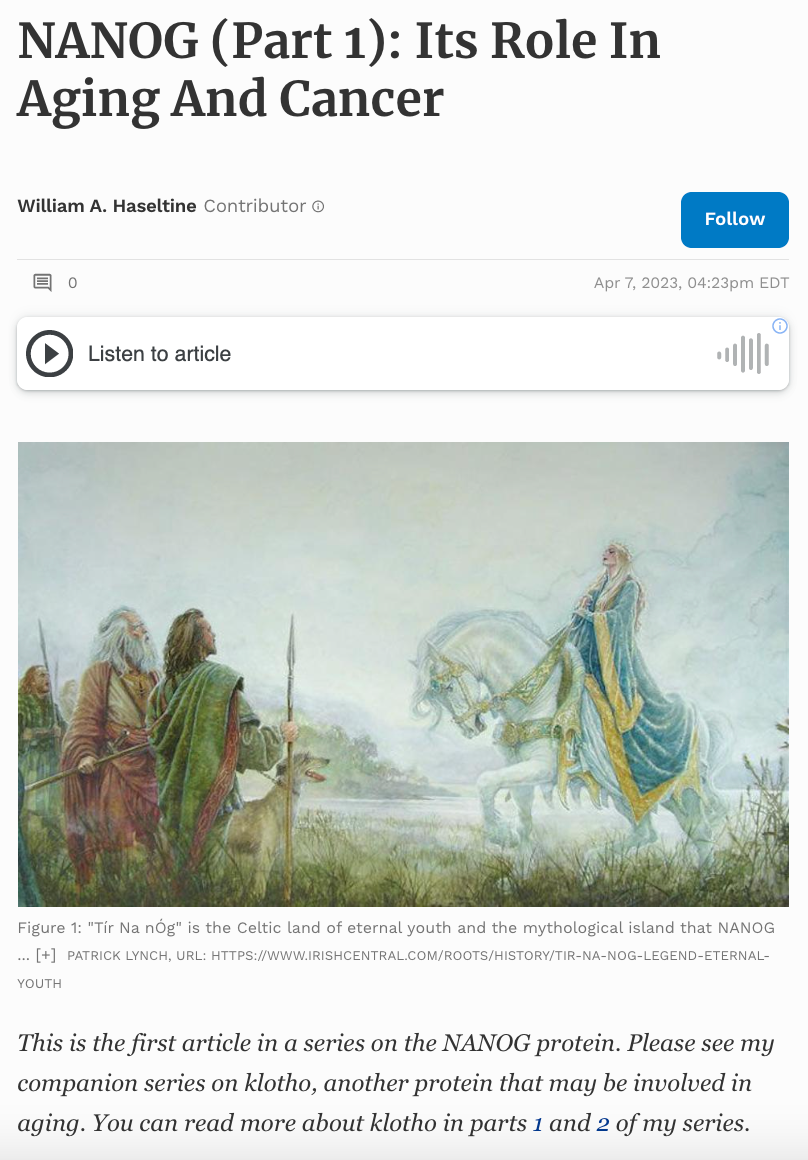This is the first article in a series on the NANOG protein. Please see my companion series on klotho, another protein that may be involved in aging. You can read more about klotho in parts 1 and 2 of my series.
In Celtic mythology, Tír na nÓg is an island paradise and supernatural realm filled with everlasting youth, beauty, health, abundance, and joy. The inhabitants of Tír na nÓg consist of warriors and gods who are known for their poetry, music, and entertainment. By participating in the feast of Goibniu, the inhabitants of the island are granted immortality, giving Tír na nÓg its nickname— “The Land of Youth”.
Now, studies report that a protein named after this Celtic tale—NANOG— may play a role in anti-aging and cancer prevention, but what is NANOG and why do researchers believe that it may prevent aging?
What is NANOG?
The key to NANOG and its biological function lies in our embryonic stem cells. Stem cells are a unique cell type, containing two characteristics that make them very powerful: pluripotency and the ability for self-renewal.
Pluripotency is the ability of stem cells to develop into many different tissues or cell types. While all embryonic stem cells are essentially the same basic cell, each stem cell has the potential to grow into nearly any tissue or cell type in the body. In other words, a single stem cell has “multiple fates” and depending on the environmental and chemical cues the stem cell is given, it can become anything from a brain cell to a muscle cell.

This becomes an especially important property when considering that stem cells have the ability to self-renew. Unlike many other cells, embryonic stem cells can simply divide to create multiples of themselves, allowing them to exist perpetually in the body so long as they can continue to self-renew.
What allows these stem cells to not only constantly regenerate, but to maintain their pluripotency? In other words, when new stem cells are created, what prevents them from spontaneously maturing into some form of adult cell?
Both pluripotency and self-renewal have been linked to a few, core transcription factors. Transcription factors are proteins in the body that control whether genes are turned on or off. Previous studies have found that the core transcription factors controlling “stemness” are Oct4, Sox2, Klf4, and NANOG.
How NANOG maintains pluripotency and self-renewal
An interesting aspect of NANOG is that it does not exist in adult cells. Instead, NANOG is only detected in stem cells that are still pluripotent—they have not begun to differentiate or develop into any particular cell type. Once a stem cell begins to differentiate, the NANOG gene is turned off and NANOG protein is no longer produced in the cell. Due to this observation, scientists suggest that NANOG may play a role in maintaining the pluripotency of stem cells, essentially preventing the stem cells from differentiating and maturing into adult cells.
There are three NANOG proteins that influence the pluripotency of human embryonic stem cells. These are Nanog1, Nanog2, and NanogP8. Researchers have found that when Nanog1 is abundant, it can prevent embryonic stem cells from differentiating. When the protein is scarce, embryonic stem cells tend to mature and differentiate into other cell types, losing their pluripotency.
NanogP8 is similar to Nanog1 except that it is mainly found in cancer cells, suggesting that NanogP8 may have larger anti-cancer properties than anti-aging properties.
How exactly could NANOG prevent stem cells from differentiating? While it is currently unclear what the biological mechanisms of NANOG are, two proteins that might offer a clue are leukemia inhibitory factor and STAT3. Both leukemia inhibitory factor proteins and STAT3 are widely known to prevent the differentiation of stem cells.
Leukemia inhibitory factor plays an important role in a wide array of biological processes including the growth of leukemia cancer cells and inflammation. The protein works primarily by controlling the activity of other transcription factors and proteins including STAT3. Researchers have found that when leukemia inhibitory factor levels drop and STAT3 activity decreases, stem cells begin to differentiate.
Interestingly, more recent experiments have shown that when NANOG is deficient, stem cells also differentiate. This occurs even in the presence of STAT3 and leukemia inhibitory factor, suggesting that NANOG may help maintain the pluripotency of stem cells by controlling the production and release of leukemia inhibitory factor and STAT3.
Additional studies focus on how NANOG may interact with other core transcription factors like Oct4 to prevent the differentiation of stem cells and maintain pluripotency. Researchers have suggested that NANOG and Oct4 may work together to control certain genes and proteins related to the pluripotency of stem cells. Oct4 is a transcription factor that is critically involved in the self-renewal of embryonic stem cells. Studies have shown that NANOG and Oct4 exhibit very similar patterns of behavior and often regulate similar genes in the body. This has led to the suspicion that NANOG and Oct4 may play a combined role in maintaining the pluripotency and self-renewal of embryonic stem cells.
Conclusion: NANOG in aging and cancer
While the biological mechanisms of how NANOG maintains the pluripotency of stem cells are unclear, it is evident that this small protein has an unusual ability to determine whether or not cells mature into different cell types. In the next installments of this short series, I will detail some of the more recent studies on NANOG, how the protein may prevent cellular aging, and how it could play a role in minimizing the growth of cancerous tumors.


